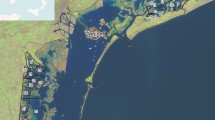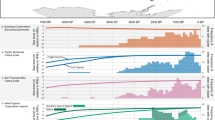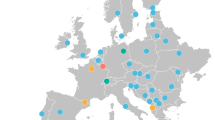Abstract
Historical ecologists working in the Neotropics argue that the present natural environment is an historical product of human intentionality and ingenuity, a creation that is imposed, built, managed and maintained by the collective multigenerational knowledge and experience of Native Americans1,2. In the past 12,000 years, indigenous peoples transformed the environment, creating what we now recognize as the rich ecological mosaic of the Neotropics3,4,5,6. The prehispanic savanna peoples of the Bolivian Amazon built an anthropogenic landscape through the construction of raised fields, large settlement mounds, and earthen causeways7,8. I have studied a complex artificial network of hydraulic earthworks covering 525 km2 in the Baures region of Bolivia. Here I identify a particular form of earthwork, the zigzag structure, as a fish weir, on the basis of form, orientation, location, association with other hydraulic works and ethnographic analogy. The native peoples used this technology to harvest sufficient animal protein to sustain large and dense populations in a savanna environment.
This is a preview of subscription content, access via your institution
Access options
Subscribe to this journal
Receive 51 print issues and online access
$199.00 per year
only $3.90 per issue
Buy this article
- Purchase on Springer Link
- Instant access to full article PDF
Prices may be subject to local taxes which are calculated during checkout





Similar content being viewed by others
References
Posey, D. & Balée, W. (eds) Resource Management in Amazonia: Indigenous and Folk Strategies (Advances in Economic Botany Vol. 7, New York Botanical Gardens, Bronx, 1989).
Balée, W. (ed.) Advances in Historical Ecology (Columbia Univ. Press, New York, 1998).
Stahl, P. W. Holocene biodiversity: An archaeological perspective from the Americas. Annu. Rev. Anthropol. 25, 105–126 (1996).
Denevan, W. M. The pristine myth: The landscape of the Americas in 1492. Ann. Ass. Am. Geog. 82, 369–385 (1992).
Piperno, D. & Pearsall, D. Origins of Agriculture in the Lowland Neotropics (Academic, San Diego, 1998).
Roosevelt, A. C. et al. Paleoindian cave dwellers in the Amazon: The peopling of the Americas. Science 272, 373– 384 (1996).
Denevan, W. M. The Aboriginal Cultural Geography of the Llanos de Mojos of Bolivia (Univ. California Press, Berkeley, 1966).
Erickson, C. L. in Archaeology in the American Tropics: Current Analytical Methods and Applications (ed. Stahl, P.) 66–95 (Cambridge Univ. Press, Cambridge, 1995).
Hanagarth, W. Acerca de la geoecología de las sabanas del Beni en el noreste de Bolivia 134 (Instituto de Ecología, La Paz, 1993).
Eder, F. J. Breve Descripcion de las Reducciones de Mojos (Historia Boliviana, Cochabamba, 1985 [1772]).
Jones, J. Conflict between Whites and Indians on the Llanos de Moxos, Beni Department Dissertation. Univ. Florida (1980).
de Castillo, J. in Documentos para la Historia Geográfica de la República de Bolivia:Las Provincias de Mojos y Chiquitos (ed. Ballivián, M. V.) Vol. 1 308–317 (J. M. Gamarra, Pa Paz, 1906 [1676]).
Riester, J. Los Guarasug’we: Crónica de sus últimos días (Editorial Los Amigos del Libro, La Paz, 1977).
Ortiz Lema, E. Los Matacos Noctenes de Bolivia (Editorial los Amigos del Libro, La Paz, 1986).
Beckerman, S. in Amazonian Indians from Prehistory to the Present: Anthropological Perspectives (ed. Roosevelt, A.) 177–200 (Univ. Arizona Press, Tucson, 1994).
Chernela, J. M. The Wanano Indians of the Brazilian Amazon: A Sense of Place (Univ. Texas Press, Austin, 1993).
Nordenskiöld, E. The Ethnography of South America seen from Mojos in Bolivia Comparative Ethnographical Studies 3 86–102 (Goteborg, 1924).
Erickson, C. L. in Vías Precolombinas: Los Caminos, Los Ingenieros Y Los Viajeros (eds Herrera, L. & Cardale de Schrimpff, M.) (Editorial Abya Yala y El Instituto Colombiano de Antropología, Bogotá, Colombia, in the press).
Garson, A. Comment upon the economic potential of fish utilization in riverine environments and the potential archaeological biases. Am. Antiquity 45, 62–567 (1980).
Dougherty, B. & Calandra, H. Relaciones de la Sociedad Argentino de Antropología Vol. 16, 37– 61 Ambiente y arqueología en el oriente boliviano: La Provincia de Iténez del Departmento Beni. (1984–5).
Schmitz, P. I., Rogge, J., Rosa, A. & Beber, M. Aterros indígenas no Pantanal do Mato Grosso do Sul (Pesquisas Antropologia no. 54, Instituto Anchietano de Pesquisas, Rio Grande do Sul, 1998).
Moholy-Nagy, H. The utilization of Pomacea snails at Tikal, Guatemala. Am. Antiquity 43, 65–73 ( 1978).
Swing, C. K., Isley, W. & Lutz, M. W. Notas sobre la ecología reproductiva del caracol. Pomacea gigas. Ecología en Bolivia 10, 19–31 (1987).
Clement, C. R. in Tropical Forests, People and Food (eds Hladik, C. M. et al.) 139–154 (The Parthenon, Paris, 1993).
Beckerman, S. The abundance of protein in Amazonia: A reply to Gross. Am. Anthropol. 81, 533–561 ( 1989).
Smith, N. J. H. The Amazon River Forest: A Natural History of Plants, Animals and People (Oxford Univ. Press, New York, 1999).
Lee, K. Complejo Hidráulico de las llanuras de Baures (Area a ser protegida), Provincia Iténez, Departamento del Beni, República de Bolivia (unpublished report). (CORDEBENI, Trinidad, 1995).
Erickson, C. L., Winkler, W. & Candler, K. Las investigaciones arqueológicas en la región de Baures en 1996 (unpublished report). (Instituto Nacional de Arqueología de Bolivia, La Paz, 1997).
Acknowledgements
Fieldwork and analysis were supported by the NSF, the Heinz Charitable Trust Foundation, the American Philosophical Society, the Research Funds of the University of Pennsylvania Museum, and Corporación del Beni. K. Lee originally reported the earthworks of Baures in the late 1950s. A.Vranich, O. Saavedra and F. Bruckner did the first study of the Baures earthworks in 1995. I thank the Bolivian Dirección Nacional de Arqueología y Antropología, the Prefectura and Alcaldia of the Department of the Beni, authorities of Baures and Bella Vista, W. Winkler (project co-investigator), K. Lee, H. Schlink, R. Bottega, R. Pinto Parada, E. Bruckner, A. Bruckner, C. Bruckner, O. Rivera, R. Langstroth, W. Denevan, A. Vranich, P. Stahl, R. Dunn and D. Brinkmeier.
Author information
Authors and Affiliations
Corresponding author
Rights and permissions
About this article
Cite this article
Erickson, C. An artificial landscape-scale fishery in the Bolivian Amazon. Nature 408, 190–193 (2000). https://doi.org/10.1038/35041555
Received:
Accepted:
Issue Date:
DOI: https://doi.org/10.1038/35041555
This article is cited by
-
Aquaculture in the Ancient World: Ecosystem Engineering, Domesticated Landscapes, and the First Blue Revolution
Journal of Archaeological Research (2023)
-
Archaeological Evidence of the Development of a Regional Society in Santarém (AD 1000–1600), Lower Amazon: A Path to Understanding Social Complexity
Journal of World Prehistory (2023)
-
Lidar reveals pre-Hispanic low-density urbanism in the Bolivian Amazon
Nature (2022)
-
Geolocation of unpublished archaeological sites in the Peruvian Amazon
Scientific Data (2021)
-
Reconstructing Holocene landscape and environmental changes at Lago Rogaguado, Bolivian Amazon
Journal of Paleolimnology (2021)
Comments
By submitting a comment you agree to abide by our Terms and Community Guidelines. If you find something abusive or that does not comply with our terms or guidelines please flag it as inappropriate.



